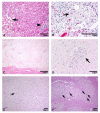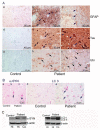CNS, lung, and lymph node involvement in Gaucher disease type 3 after 11 years of therapy: clinical, histopathologic, and biochemical findings
- PMID: 25219293
- PMCID: PMC4312736
- DOI: 10.1016/j.ymgme.2014.08.011
CNS, lung, and lymph node involvement in Gaucher disease type 3 after 11 years of therapy: clinical, histopathologic, and biochemical findings
Abstract
A Caucasian male with Gaucher disease type 3, treated with continuous enzyme therapy (ET) for 11 years, experienced progressive mesenteric and retroperitoneal lymphadenopathy, lung disease, and neurological involvement leading to death at an age of 12.5 years. Autopsy showed significant pathology of the brain, lymph nodes, and lungs. Liver and spleen glucosylceramide (GluCer) and glucosylsphingosine (GluS) levels were nearly normal and storage cells were cleared. Clusters of macrophages and very elevated GluCer and GluS levels were in the lungs, and brain parenchymal and perivascular regions. Compared to normal brain GluCer (GC 18:0), GluCer species with long fatty acid acyl chains were increased in the patient's brain. This profile was similar to that in the patient's lungs, suggesting that these lipids were present in brain perivascular macrophages. In the patient's brain, generalized astrogliosis, and enhanced LC3, ubiquitin, and Tau signals were identified in the regions surrounding macrophage clusters, indicating proinflammation, altered autophagy, and neurodegeneration. These findings highlight the altered phenotypes resulting from increased longevity due to ET, as well as those in poorly accessible compartments of brain and lung, which manifested progressive disease involvement despite ET.
Keywords: Enzyme replacement therapy; Gaucher disease; Lymphadenopathy; Lysosomal storage disease; Pathology.
Copyright © 2014 Elsevier Inc. All rights reserved.
Figures






Similar articles
-
Neuronopathic Gaucher disease in the mouse: viable combined selective saposin C deficiency and mutant glucocerebrosidase (V394L) mice with glucosylsphingosine and glucosylceramide accumulation and progressive neurological deficits.Hum Mol Genet. 2010 Mar 15;19(6):1088-97. doi: 10.1093/hmg/ddp580. Epub 2010 Jan 4. Hum Mol Genet. 2010. PMID: 20047948 Free PMC article.
-
Elevated plasma glucosylsphingosine in Gaucher disease: relation to phenotype, storage cell markers, and therapeutic response.Blood. 2011 Oct 20;118(16):e118-27. doi: 10.1182/blood-2011-05-352971. Epub 2011 Aug 25. Blood. 2011. PMID: 21868580 Free PMC article.
-
Systemic delivery of a glucosylceramide synthase inhibitor reduces CNS substrates and increases lifespan in a mouse model of type 2 Gaucher disease.PLoS One. 2012;7(8):e43310. doi: 10.1371/journal.pone.0043310. Epub 2012 Aug 17. PLoS One. 2012. PMID: 22912851 Free PMC article.
-
Value of Glucosylsphingosine (Lyso-Gb1) as a Biomarker in Gaucher Disease: A Systematic Literature Review.Int J Mol Sci. 2020 Sep 28;21(19):7159. doi: 10.3390/ijms21197159. Int J Mol Sci. 2020. PMID: 32998334 Free PMC article.
-
Ophthalmic manifestations of Gaucher disease: the most common lysosomal storage disorder.Br J Ophthalmol. 2019 Mar;103(3):315-326. doi: 10.1136/bjophthalmol-2018-312846. Epub 2019 Jan 5. Br J Ophthalmol. 2019. PMID: 30612093 Review.
Cited by
-
Intravenous infusion of iPSC-derived neural precursor cells increases acid β-glucosidase function in the brain and lessens the neuronopathic phenotype in a mouse model of Gaucher disease.Hum Mol Genet. 2019 Oct 15;28(20):3406-3421. doi: 10.1093/hmg/ddz184. Hum Mol Genet. 2019. PMID: 31373366 Free PMC article.
-
Reduced progranulin increases tau and α-synuclein inclusions and alters mouse tauopathy phenotypes via glucocerebrosidase.Nat Commun. 2024 Feb 16;15(1):1434. doi: 10.1038/s41467-024-45692-3. Nat Commun. 2024. PMID: 38365772 Free PMC article.
-
Identification of a biomarker in cerebrospinal fluid for neuronopathic forms of Gaucher disease.PLoS One. 2015 Mar 16;10(3):e0120194. doi: 10.1371/journal.pone.0120194. eCollection 2015. PLoS One. 2015. PMID: 25775479 Free PMC article.
-
Gaucher disease - more than just a rare lipid storage disease.J Mol Med (Berl). 2022 Apr;100(4):499-518. doi: 10.1007/s00109-021-02174-z. Epub 2022 Jan 23. J Mol Med (Berl). 2022. PMID: 35066608 Review.
-
Successful therapy for protein-losing enteropathy caused by chronic neuronopathic Gaucher disease.Mol Genet Metab Rep. 2015 Dec 29;6:13-5. doi: 10.1016/j.ymgmr.2015.12.001. eCollection 2016 Mar. Mol Genet Metab Rep. 2015. PMID: 27014572 Free PMC article.
References
-
- Grabowski G, Petsko G, Kolodny E. Gaucher Disease. In: Valle D, Beaudet A, Vogelstein B, Kinzler K, Antonarakis S, Ballabio A, Gibson K, Mitchell G, editors. The Online Metabolic and Molecular Bases of Inherited Disease. The McGraw-Hill Companies, Inc.; New York, NY: [Accessed on; 06/23/14]. 2010. Chapt 146.
-
- Altarescu G, Hill S, Wiggs E, Jeffries N, Kreps C, Parker CC, Brady RO, Barton NW, Schiffmann R. The efficacy of enzyme replacement therapy in patients with chronic neuronopathic Gaucher’s disease. J Pediatr. 2001;138:539–547. - PubMed
-
- Burrow TA, Cohen MB, Bokulic R, Deutsch G, Choudhary A, Falcone RA, Jr., Grabowski GA. Gaucher disease: progressive mesenteric and mediastinal lymphadenopathy despite enzyme therapy. J Pediatr. 2007;150:202–206. - PubMed
-
- Grabowski GA, Leslie N, Wenstrup R. Enzyme therapy for Gaucher disease: the first 5 years. Blood Rev. 1998;12:115–133. - PubMed
-
- Zhao H, Bailey LA, Elsas LJ, 2nd, Grinzaid KA, Grabowski GA. Gaucher disease: in vivo evidence for allele dose leading to neuronopathic and nonneuronopathic phenotypes. Am J Med Genet A. 2003;116A:52–56. - PubMed
Publication types
MeSH terms
Substances
Grants and funding
LinkOut - more resources
Full Text Sources
Other Literature Sources
Medical
Miscellaneous
